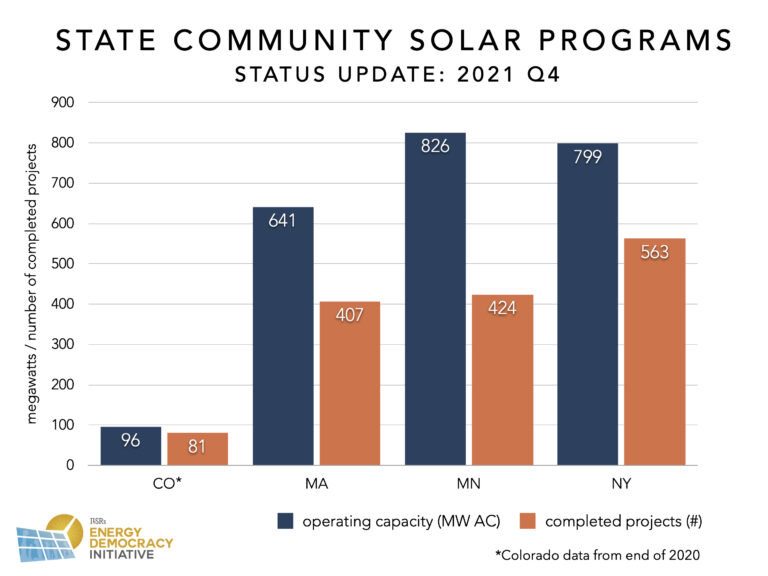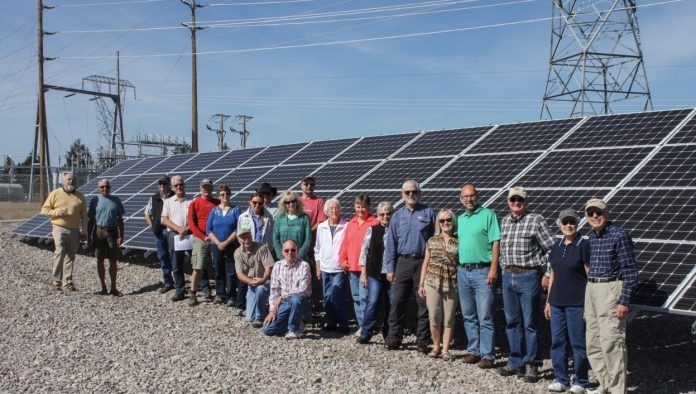Achieving the US government’s ambitious climate goals will take an all-hands-on-deck approach. Several studies have looked at how much solar must be installed to meet the goal of 80% clean electricity by 2030, and the consensus is that at least 103GW of distributed solar and 137GW of distributed storage must be deployed every year in order to achieve the President’s goals at the lowest cost.
Another of the President’s goals is to deliver at least 40% of the overall benefits from federal investments in climate and clean energy to low- to moderate-income (LMI) individuals. Key to what is called the Justice40 initiative is a new focus on community solar, which is a way to build a more equitable clean energy grid. Not everyone can put solar on their roof—some live in apartment buildings or condos, their roof may not be oriented to benefit from solar, or the residents may not be able to afford the up-front cost of solar or may not have the credit needed to finance.
The community solar model enables members subscribe to a portion of a solar array, usually located in or near their community. As the solar array produces energy, subscribers receive a portion of the revenue from the energy produced, typically as a savings on their monthly electric bill — a critical factor for low-income and disadvantaged communities whose energy burden is three times higher than for non-low-income households.
US commitment
At the annual summit of the National Community Solar Partnership (NCSP) in January, the DOE announced a goal of powering the equivalent of five million households by 2025 with community solar and creating $1 billion in energy savings. Achieving this target would mean an increase of more than 700% of installed community solar in the next four years.
“With the combination of DOE’s NCSP initiatives and the adoption of other critical actions by state and federal policymakers, the industry can meet this goal and satisfy pent up demand, save American consumers and businesses money, create local jobs, enhance grid resilience and protect the environment and community health,” said Jeff Cramer, President and CEO of CCSA.
While the community solar industry experienced a record-breaking year of growth in 2020, to continue that trajectory the expansion barriers must be removed and incentives offered. At the Community Solar Power Forum held Boston at the end of February, five key takeaways highlight the challenges for the industry:
More work remains in order to make community solar more equitable
Policymakers, utilities, and regulators must establish goals and incentives that lead to better interconnection outcomes
States must pass their own community solar bills
Existing community solar markets need to evolve credit rate structures, streamline interconnection, and ensure a long-term path for continued program capacity
New potential growth markets need to get utilities on board and create a sense of urgency.
Making community solar equitable
The median income for a household that has adopted solar has historically been higher than the average US household, however, there seems to be a shift underway. Researchers at Lawrence Berkeley National Laboratory released the latest edition of the annual report, Residential Solar-Adopter Income and Demographic Trends, which looks at 2.3 million residential solar adopters across the country in 2020, representing 82% of all US systems. The study showed that the disparity between solar-adopter incomes and the general population has been narrowing over time: Between 2010 and 2020, median solar-adopter incomes in the US fell on an absolute basis from $138k to $115k. The researchers reported that the drop reflects the fact that the solar market is deepening, by appealing to less affluent households, and it is broadening into less affluent states. This is good news because, according to the DOE, low-income households face a disproportionately higher energy burden (energy burden is the percentage of gross household income spent on energy costs.
The Solar Energy Technologies Office (SETO) of the DOE has a goal of accelerating “the development and deployment of solar technology to support an equitable transition to a decarbonized electricity system by 2035 and decarbonized energy sector by 2050”. SETO is developing strategies for expanding equitable access to solar energy by trying to solve financing, business, market, and other barriers for residential and community solar.
“Community solar is one of the most powerful tools we have to provide affordable solar energy to all American households, regardless of whether they own a home or have a roof suitable for solar panels,” said Secretary Jennifer M. Granholm. “Achieving these ambitious targets will lead to meaningful energy cost savings, create jobs in these communities, and make our clean energy transition more equitable.”
Interconnection issues
Both Wood Mackenzie and the Institute for Local Self Reliance have recently identified interconnection as the most significant barrier to expanding distributed energy resources (DER). PJM, the nation’s largest electrical grid operator responded to its backlog of over 1,200 energy projects not by speeding up review of applications, but instead by pausing the review process for two years—a response that many industry experts discussed at the recent RE+ Northeast.
The white paper, “Integrating Distributed Solar and Storage: The Keystones of a Modern Grid,” provides specific recommendations and cites many examples of state and agency efforts that have made progress improving interconnection and DER integration practices to help guide policymakers, regulators, and utilities with respect to the steps they must take. The white paper outlines four strategies for reforming the interconnection process: developing and implementing improved interconnection procedures; compensating utilities to integrate DERs; fairly distributing costs to update the grid among all customers who benefit from increased grid resilience; and providing clean, cost-effective electricity to all Americans.
“Following the recommendations in this report will make utilities more of a partner and less of an obstacle to rooftop and community solar interconnection,” said Sean Gallagher, vice president of state and regulatory affairs at the Solar Energy Industries Association (SEIA).
Siting and interconnection woes lower forecasts
Nearly three-quarters of the US market for community solar is concentrated in four states: Florida, Massachusetts, Minnesota, and New York, although 22 states and Washington, D.C. currently have state policies that support community solar deployment. “Community solar needs state-level polices in order to thrive,” said Rachel Goldstein, an analyst with Wood Mackenzie. New Mexico and Delaware both passed legislation in 2021 for new or improved community solar programs. Michigan, Ohio, Pennsylvania, and Wisconsin all have proposed bills working their way through state legislatures.

Goldstein noted that Minnesota and Maryland’s forecasts decreased due to continued siting challenges in both states. The forecasts for Massachusetts and Maine have also been revised downwards due to delays related to interconnection studies. “As community solar penetrates more markets, it will have to contend with interconnection challenges due to grid congestion and outdated infrastructure,” Goldstein said. The Wood Mackenzie report stressed that interconnection difficulties represent a major challenge facing the community solar sector and is one that will continue in the coming years.






